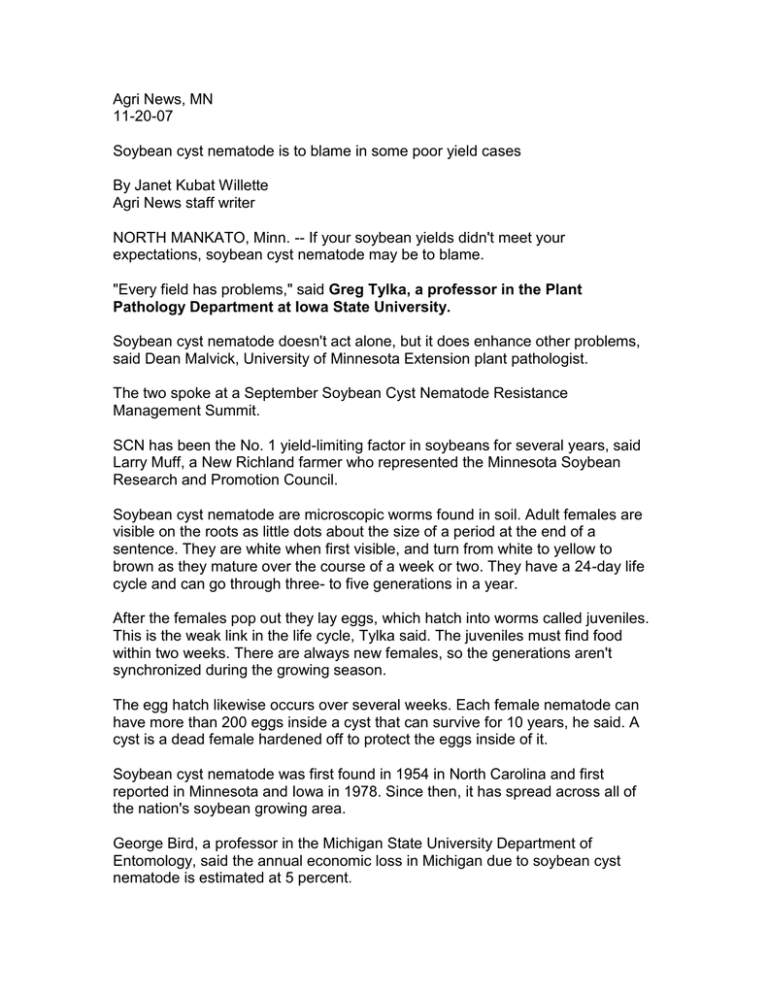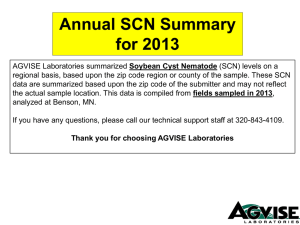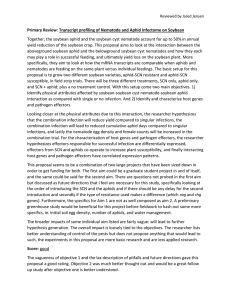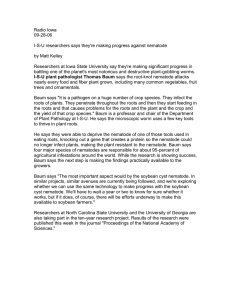Agri News, MN 11-20-07
advertisement

Agri News, MN 11-20-07 Soybean cyst nematode is to blame in some poor yield cases By Janet Kubat Willette Agri News staff writer NORTH MANKATO, Minn. -- If your soybean yields didn't meet your expectations, soybean cyst nematode may be to blame. "Every field has problems," said Greg Tylka, a professor in the Plant Pathology Department at Iowa State University. Soybean cyst nematode doesn't act alone, but it does enhance other problems, said Dean Malvick, University of Minnesota Extension plant pathologist. The two spoke at a September Soybean Cyst Nematode Resistance Management Summit. SCN has been the No. 1 yield-limiting factor in soybeans for several years, said Larry Muff, a New Richland farmer who represented the Minnesota Soybean Research and Promotion Council. Soybean cyst nematode are microscopic worms found in soil. Adult females are visible on the roots as little dots about the size of a period at the end of a sentence. They are white when first visible, and turn from white to yellow to brown as they mature over the course of a week or two. They have a 24-day life cycle and can go through three- to five generations in a year. After the females pop out they lay eggs, which hatch into worms called juveniles. This is the weak link in the life cycle, Tylka said. The juveniles must find food within two weeks. There are always new females, so the generations aren't synchronized during the growing season. The egg hatch likewise occurs over several weeks. Each female nematode can have more than 200 eggs inside a cyst that can survive for 10 years, he said. A cyst is a dead female hardened off to protect the eggs inside of it. Soybean cyst nematode was first found in 1954 in North Carolina and first reported in Minnesota and Iowa in 1978. Since then, it has spread across all of the nation's soybean growing area. George Bird, a professor in the Michigan State University Department of Entomology, said the annual economic loss in Michigan due to soybean cyst nematode is estimated at 5 percent. The key to managing soybean cyst nematodes is keeping the population low, Tylka said. The higher the population rises, the more potential there is for yield damage, he said. There are two ways to scout for nematodes: Either dig plants and check the roots beginning about six weeks after planting to look for females on the roots or take soil samples, Tylka said. "You can not eliminate soybean cyst nematode," said James Orf, a professor in the University of Minnesota Department of Agronomy and Plant Genetics. "Once it's in your field you just manage it." The two best ways to manage SCN are to grow non-host crops and to grow resistant soybean varieties, Tylka said. Rotate, rotate, rotate, said Terry Niblack, a professor in the University of Illinois Crop Sciences Department. Alternate between non-host crops and resistant varieties. Also vary types of resistance. Nematodes feed only on host crops and a percentage will die if non-host crops are grown, Tylka said. But for every bit of good news, there is bad news in the fight against nematodes, Tylka said. Some eggs hatch only when they sense soybean roots and some eggs are dormant for a number of years. Studies have shown nematode numbers drop from 5 percent to 50 percent in a year when corn was grown. But studies have also shown that the numbers don't fall much with a second or third year of corn on the same field. Then there's resistant varieties. There is no legal definition of resistance, so it's commonly defined as allowing less than 10 percent reproduction, Tylka said. Moderately resistant is allowing 10 percent to 30 percent reproduction. Current resistant varieties don't have a yield drag, Bird said. Not all resistance is created equal. Similarly, not all soybean cyst nematode populations are the same. The difference in soybean cyst nematode reproduction is due to the genetics of the resistant soybean and the genetics of the soybean cyst nematode population. If the same resistance trait is planted year after year, the nematode population may become resistant to resistance. New and improved soybean cyst nematode strategies, tactics and products are imperative for long-term resolution of the SCN challenge, Bird said. The challenge is to find high-yielding, early maturing varieties with SCN resistance, Orf said. Producers aren't willing to grow resistant varieties without high-yield potential.







